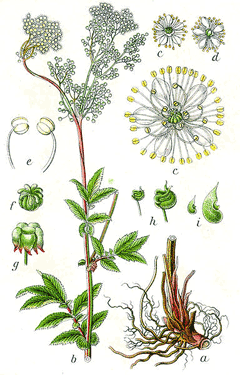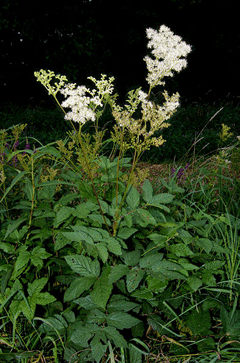 |
|
http://commons.wikimedia.org/wiki/File:Filipendula_ulmaria_Sturm12.jpg |
 |
| http://commons.wikimedia.org/wiki/User:Fice |
Translate this page:
Summary
Bloom Color: White. Main Bloom Time: Late summer, Mid summer. Form: Upright or erect.
Physical Characteristics

 Filipendula ulmaria is a PERENNIAL growing to 1.2 m (4ft) by 0.4 m (1ft 4in) at a medium rate.
Filipendula ulmaria is a PERENNIAL growing to 1.2 m (4ft) by 0.4 m (1ft 4in) at a medium rate.
See above for USDA hardiness. It is hardy to UK zone 2 and is not frost tender. It is in flower from June to August, and the seeds ripen from August to September. The species is hermaphrodite (has both male and female organs) and is pollinated by Bees, flies, beetles. The plant is self-fertile.
It is noted for attracting wildlife.
Suitable for: light (sandy), medium (loamy) and heavy (clay) soils and can grow in heavy clay soil. Suitable pH: neutral and basic (mildly alkaline) soils. It can grow in semi-shade (light woodland) or no shade. It prefers moist or wet soil.
UK Hardiness Map
US Hardiness Map
Synonyms
Spiraea ulmaria. Ulmaria pentapetala.
Plant Habitats
Woodland Garden Dappled Shade; Shady Edge; Meadow; Bog Garden;
Edible Uses
Edible Parts: Flowers Leaves Root
Edible Uses: Condiment Tea
All parts of the plant are edible. Root - cooked[2, 141]. Young leaves - cooked as a flavouring in soups[177]. Young leaves, flowers and roots are brewed into a tea[183]. The dried leaves are used as a flavouring[12, 100], especially as a sweetener in herb teas[13, 183]. The flowers are used as a flavouring in various alcoholic beverages and in stewed fruits[183]. Adding them to wine or beer is said to make a very heady brew[244]. They are also made into a syrup which can be used in cooling drinks and fruit salads[183].
References More on Edible Uses
Medicinal Uses
Plants For A Future can not take any responsibility for any adverse effects from the use of plants. Always seek advice from a professional before using a plant medicinally.
Alterative Antiinflammatory Antirheumatic Antiseptic Aromatic Astringent Diaphoretic Diuretic
Dysentery Homeopathy Stomachic Tonic
Meadowsweet has a very long history of herbal use, it was one of the three most sacred herbs of the Druids[238]. The leaves and flowering stems are alterative, anti-inflammatory, antiseptic, aromatic, astringent, diaphoretic, diuretic, stomachic and tonic[4, 9, 21, 165]. The plant is harvested in July when it is in flower and can be dried for later use[4]. The flower head contains salicylic acid, from which the drug aspirin can be synthesised[200, 238]. Unlike the extracted aspirin, which can cause gastric ulceration at high doses, the combination of constituents in meadowsweet act to protect the inner lining of the stomach and intestines whilst still providing the anti-inflammatory benefits of aspirin[254]. The herb is a valuable medicine in the treatment of diarrhoea, indeed it is considered almost specific in the treatment of children's diarrhoea[4]. It is also considered to be a useful stomachic, being used to treat hyperacidity, heartburn, gastritis and peptic ulcers, for which it is one of the most effective plant remedies[4, 238]. It is also frequently used in the treatment of afflictions of the blood[4]. Meadowsweet is also effective against the organisms causing diphtheria, dysentery and pneumonia[238]. This remedy should not be given to people who are hypersensitive to aspirin[238]. A strong decoction of the boiled root is said to be effective, when used externally, in the treatment of sores and ulcers[244]. A homeopathic remedy is made from the fresh root[9]. The German Commission E Monographs, a therapeutic guide to herbal medicine, approve Filipendula ulmaria Meadowsweet for cough, bronchitis, fever and cold (see [302] for critics of commission E).
References More on Medicinal Uses
The Bookshop: Edible Plant Books
Our Latest books on Perennial Plants For Food Forests and Permaculture Gardens in paperback or digital formats.

Edible Tropical Plants
Food Forest Plants for Hotter Conditions: 250+ Plants For Tropical Food Forests & Permaculture Gardens.
More

Edible Temperate Plants
Plants for Your Food Forest: 500 Plants for Temperate Food Forests & Permaculture Gardens.
More

More Books
PFAF have eight books available in paperback and digital formats. Browse the shop for more information.
Shop Now
Other Uses
Dye Essential Pot-pourri Strewing
A black dye is obtained from the roots. It is brown[141]. A yellow dye is obtained from the plant tops[106]. An essential oil obtained from the flower buds is used in perfumery[46, 61]. The whole plant, but especially the leaves[245], was formerly used as a strewing herb, imparting an almond-like fragrance[4, 66]. Strongly aromatic, its delightful perfume would completely fill the room[244]. Both flowers and leaves have been used in pot-pourri, retaining their scent for several months. The scent of the dried flowers becoming more and more pleasant with age[245].
Special Uses
Attracts Wildlife Food Forest Scented Plants
References More on Other Uses
Cultivation details
Landscape Uses:Border, Massing, Rock garden, Seashore, Specimen, Woodland garden. Requires a humus-rich moist soil in semi-shade[200]. Succeeds in full sun only if the soil is reliably moist throughout the growing season[200]. Dislikes dry or acid soils[1, 17]. Does well in marshy soils[24, 200]. Grows well in heavy clay soils. The flowers have a strong sweet smell[4], which for many people is sickly[245]. The leaves are also aromatic[187], though the scent is very different from the flowers[4]. The leaves are pleasantly aromatic[245]. A good bee plant[24, 30]. Members of this genus are rarely if ever troubled by browsing deer[233]. Special Features:Attractive foliage, Edible, Fragrant foliage, Not North American native, Naturalizing, Suitable for cut flowers, Suitable for dried flowers, Fragrant flowers.
References Carbon Farming Information and Carbon Sequestration Information
Temperature Converter
Type a value in the Celsius field to convert the value to Fahrenheit:
Fahrenheit:
The PFAF Bookshop
Plants For A Future have a number of books available in paperback and digital form. Book titles include Edible Plants, Edible Perennials, Edible Trees,Edible Shrubs, Woodland Gardening, and Temperate Food Forest Plants. Our new book is Food Forest Plants For Hotter Conditions (Tropical and Sub-Tropical).
Shop Now
Plant Propagation
Seed - best sown in the autumn in a cold frame[1]. The seed can also be sown in a cold frame in spring, germinating best at a temperature of 10 - 13°c[200]. When they are large enough to handle, prick the seedlings out into individual pots and plant them out in the summer if they have grown enough. If not, keep them in a cold frame for the winter and plant them out in late spring. Division in autumn or winter[200]. Very easy, larger clumps can be replanted direct into their permanent positions, though it is best to pot up smaller clumps and grow them on in a cold frame until they are rooting well. Plant them out in the spring.
Other Names
If available other names are mentioned here
Native Range
TEMPERATE ASIA: Turkey, Armenia, Azerbaijan, Georgia, Russian Federation-Western Siberia (Western Siberia), Russian Federation-Eastern Siberia (Eastern Siberia), Mongolia, China (Xinjiang Uygur Zizhiqu) EUROPE: Denmark, Finland, United Kingdom, Ireland, Norway, Sweden, Austria, Belgium, Switzerland, Czech Republic, Germany, Netherlands, Poland, Slovakia, Belarus, Estonia, Lithuania, Latvia, Moldova, Ukraine (incl. Krym), Albania, Bulgaria, Bosnia and Herzegovina, Greece, Croatia, North Macedonia, Montenegro, Romania, Serbia, Slovenia, France, Portugal
Weed Potential
Right plant wrong place. We are currently updating this section.
Please note that a plant may be invasive in one area but may not in your area so it's worth checking.
Conservation Status
IUCN Red List of Threatened Plants Status :

Growth: S = slow M = medium F = fast. Soil: L = light (sandy) M = medium H = heavy (clay). pH: A = acid N = neutral B = basic (alkaline). Shade: F = full shade S = semi-shade N = no shade. Moisture: D = dry M = Moist We = wet Wa = water.
Now available:
Food Forest Plants for Mediterranean Conditions
350+ Perennial Plants For Mediterranean and Drier Food Forests and Permaculture Gardens.
[Paperback and eBook]
This is the third in Plants For A Future's series of plant guides for food forests tailored to
specific climate zones. Following volumes on temperate and tropical ecosystems, this book focuses
on species suited to Mediterranean conditions—regions with hot, dry summers and cool, wet winters,
often facing the added challenge of climate change.
Read More
Expert comment
Author
(L.)Maxim.
Botanical References
17200
Links / References
For a list of references used on this page please go here
Readers comment